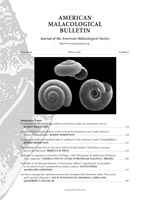Christoffer Schander was born in 1960 in Boras, Sweden. After a too short but very productive life in malacology and marine invertebrate zoology, Chris sadly and unexpectedly passed away in Bergen, Norway, on February 21, 2012. The world has been deprived of one of its most energetic and broadly-based malacologists, and one of the few systematists of Aplacophora.
Chris was characterized by imagination, a broad experience in marine invertebrate zoology and a fine sense of fun and empathy. His early experiences were as a Rotary exchange student to the U.S., a writer of science fiction, and a Captain in the Swedish Naval Reserve. He was accepted as a graduate student at Gothenburg University in 1990, where research in zoology was honed by a rigorous education culminating in a Ph.D. degree (1997). As a graduate student, he held a number of assistantships in research and teaching.
Chris wrote that his goals in research were “to understand the role that evolutionary forces and phylogeny have played in organism diversity.” More than 60 percent of his ∼90 publications are concerned with Mollusca, particularly Aplacophora and gastropod Pyramidellidae, but including Bivalvia, Scaphopoda, Polyplacophora, and terrestrial slugs. However, all invertebrates were grist to his mill of more generalized papers on molecular phylogeny and phylogenetic taxonomy, ecology, barcoding, nomenclature, biogeography, conservation, and molecular genetics. His delight was taking part in faunal surveys.
In 1998 Chris arrived at the Woods Hole Oceanographie Institution as a postdoctoral fellow on an NSF grant “Partnerships for Enhancing Expertise in Taxonomy” (PEET) for studies on the deep-sea Aplacophora. Following a stint as Chief Scientist at the Danish University Arctic Station, Queqertarsuaq (Disco), Greenland, Chris obtained a position as Professor of Marine Biodiversity at the University of Bergen, also becoming thematic leader at the Center of Excellence in Geobiology. Last year he spent a sabbatical year at Auburn University to increase his knowledge of phylogeographic and phylogenomic methods in exploring the faunal evolutionary history of Norwegian hydrothermal vents and seeps. On his return to Bergen, he became Director of the University Museum.
Chris's enthusiasm was infectious. Whenever the subject was around biology, Chris would be miles ahead leading us to look at the broader implications. He was generous with his time. When on-board a research vessel to collect all sorts of marine invertebrates, particularly in the fjords and vents off Norway, he was never happier (photo).
Besides teaching and research, Chris expended much time for funding to make Bergen a center of excellence for marine research, now being carried on by his colleagues in Bergen, the U.S., Europe, and Russia. To this end, the Christoffer Schander Memorial Fund at the University of Bergen has been established to honor his memory and to continue his eager support of cooperation and scientific exchange between individuals and institutions. Donations to the fund in the U.S. may be made through http://gump.auburn.edu/halanych/For_Chris, and in Europe through: http://www.uib.no/rg/mb/schanderfund/about-the-schander-memorial-fund.
Amélie Scheltema, Woods Hole Oceanographie Institution, Woods Hole, Massachusetts 02543.






